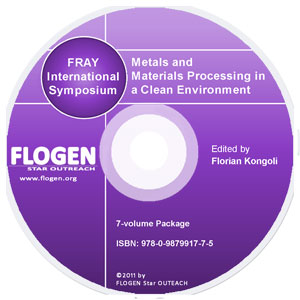
CD shopping page |
2011-Sustainable Industrial Processing Summit
|
| Editors: | Florian K |
| Publisher: | Flogen Star OUTREACH |
| Publication Year: | 2012 |
| Pages: | 764 pages |
| ISBN: | 978-0-9879917-5-1 |
| ISSN: | 2291-1227 (Metals and Materials Processing in a Clean Environment Series) |
Surface Characterization By X-ray Photoelectron Spectroscopy And Cyclic Voltammetry Of Passive Layers Formed During The Dissolution Of Chalcopyrite.
Dora Nava1;1UAM-IZTAPALAPA, Mexico, Mexico;
Type of Paper: Regular
Id Paper: 210
Topic: 14
Abstract:
This work involves a systematic study which provides insight into the electrochemical oxidation mechanisms of a chalcopyrite crystal. This was achieved through the identification and characterization of the potentiostatically formed chemical species on the surface of carbon paste electrodes with crystal chalcopyrite powder (CPE-CP) in a medium containing 1.7 M H2SO4, in the absence of oxidizing agents. The composition of the electrolyte, resulting from the imposition of a specific potential, was determined using a mercury film electrode (MFE) and anodic stripping voltammetry (ASV). The characterization of the chemical species was accomplished using cyclic voltammetry (CV) and X-Ray photoelectron spectroscopy (XPS).In the oxidation study of chalcopyrite, it was observed that this mineral dissolves quantitatively in the potential zone between 0.715 < Eanod ≤ 1.015 V vs. SHE. The existence of covellite (CuS) and a neutral sulfur species (S8o) in this potential zone, demonstrated by XPS, shows that these products are not responsible for the passivation phenomenon. The passivation is due to the slow decomposition of transient products, denominated passive non-stoichiometric polysulfides (Cu1-rFe1-sS2-t), which form at potentials below 0.715 V vs SHE. The physical and chemical properties of the neutral sulfur species S8o are different from those of elemental sulphur, permitting diffusion of the charged species. For this reason, the case for the electrochemical formation of elemental sulfur in this potential zone is discarded.